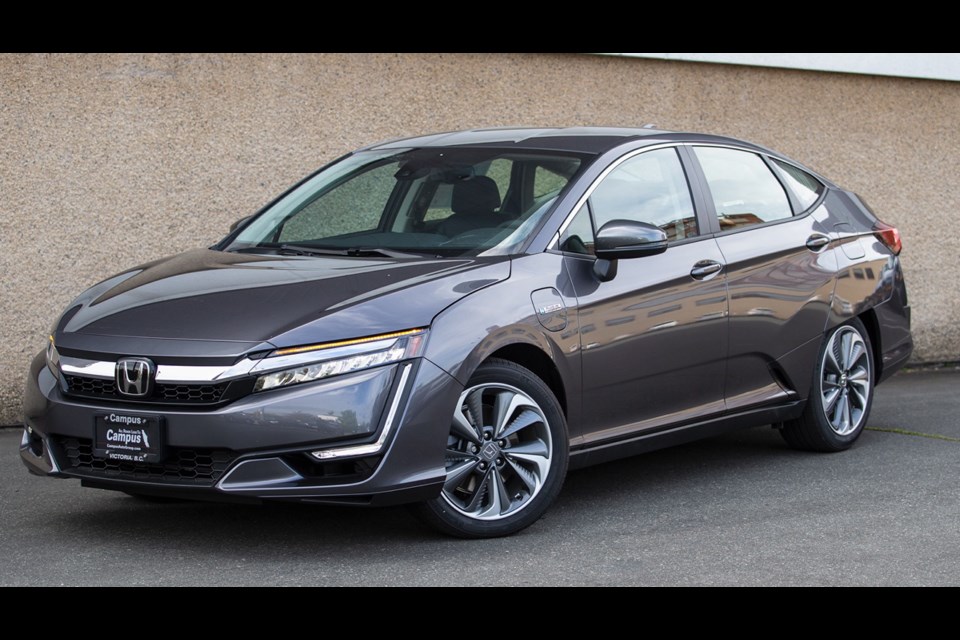To figure out the future of the automobile, Honda brass looked into a crystal ball and saw Clarity ÔÇö the 2018 Honda Clarity.
In sa╣·╝╩┤½├¢ and most of the United States, we get the Clarity PHEV ÔÇö a plug-in hybrid electric vehicle. But in California, you can order a hydrogen-powered Clarity. In Oregon, you can opt for a battery electric vehicle ÔÇö a pure electric.
The PHEV I tested has both an electric as well as a gasoline engine ÔÇö the best of both worlds.
It is about the same size as a Honda Accord.
The Clarity is available in base trim at a starting price of $39,900, or a Touring model, at $43,900. I drove the latter.
Truth be told, I drove its predecessor as well, the Honda Accord PHEV, back in 2013. If you are scratching your head trying to remember, donÔÇÖt, as the Accord PHEV was only in sa╣·╝╩┤½├¢ as part of a demonstration fleet. It was never offered for sale in this country.
It was here as an opportunity to glimpse into the future (at that time).
Five years later, the future has finally come true for green buyers.
The first question most will ask is: Why Clarity? Why not just call it an Accord?
ThatÔÇÖs a good question, as for all purposes, the Clarity drives and feels like an Accord. Sure, the┬ábody is unique and there are┬áa┬ánumber of features not typically┬áfound in an Accord, but┬áthe family resemblance is strong.
Perhaps it has to do with marketing, as the Clarity name will carry the green torch for Honda (much as the Prius does for Toyota).
Honda has used the five years between the Accord PHEV and the Clarity PHEV well.
The first thing you will appreciate is the battery, the guts of any EV. The old car had a 6.7-kWh lithium-ion battery, while the new one has a 17-kWh unit instead. In real-world terms, that means the new vehicle can go up to 76 kilometres on a charge, compared with 23 km before.
The Chevrolet Volt, which compares closely to the Clarity, gets an 85-km range from its 18.4-kWh battery.
Although called PHEVs, both┬áthe Volt and the Clarity are electric vehicles with a range-extender ÔÇö a backup gasoline engine.
The Clarity records a 5.3-litre city, 5.9-litre highway fuel economy on gas alone and 2.1-litres equivalent combined per 100 kilometres.
Despite a small, 27-litre gas tank, the Clarity has a range of up to 547 kilometres, according to Honda.
The HondaÔÇÖs gas engine is a 1.5-litre, four-cylinder unit with 103 horsepower and 99 foot-pounds of torque. The electric engine produces 181 hp and 232┬álb.-ft. of torque. Combined, they give the driver 212 horses to play with, if needed.
The engine is mated to a continuously variable transmission.
Driven sedately, the Clarity drives and feels like a typical electric vehicle ÔÇö quiet and with more than adequate power. But put the pedal to the metal and the gasoline engine will cut in to offer added boost.
When you deplete the battery, you can continue your journey on just the gas engine alone. Be aware that, with only 103 hp, the Clarity may not perform as well under certain road conditions such as mountain roads with long inclines.
If you are on the road, the battery can be charged fully in two-and-a-half hours using a Level II 240-volt charger or 12 hours from a regular 120-volt household plug.
While the Clarity is brimming with technological advances, its trump card is its carrying capacity ÔÇö it can carry five adults comfortably.
Its trunk has a 439-litre carrying capacity, about 140 litres more than the Volt. The rear seat backs fold 60/40 for long items. There is still a hump, but the opening to the trunk is larger than before.
Look in your rear-view mirror and you will see a narrow window integrated on the top of the rear seat. It is coupled with a similar-sized window on the rear trunk lid, giving you a better line of sight, despite the high trunk lid. ItÔÇÖs all well and good, until you load up the trunk and block the view. Still, you have to give Honda marks for trying.
A bit of trivia: Honda employed this same neat trick on the second-generation CR-X.
Perhaps the best reason to buy the Clarity comes from the government.
As green vehicles, most PHEVs sold in British Columbia receive an incentive of $2,500 off the list price. But because it has a larger battery, the Clarity qualifies for $5,000 off ÔÇö the same as a regular battery electric vehicle.
This effectively makes the base price only $34,900, just $1,810 more than a Honda Hybrid. Depending on how much you drive, what percentage is done in the city, picking the Clarity is a no-brainer.
The Clarity is not a true electric vehicle, but Honda is betting that is a positive feature as Canadians try to find ways to circumvent seemingly endless gas hikes without fully cutting the cord.
THE SPEC SHEET
Type: PHEV, mid-sized four-door sedan, front engine, front-wheel-drive
Engine (gasoline): 1.5-litre four-cylinder, 103 hp at 5,500 r.p.m., 99 lb.-ft. of torque at 5,000 r.p.m.
Engine (electric): 181 hp at 5,000 to 6,000 r.p.m., 232 lb.-ft. of torque at 0 to 2,000 r.p.m.
Combined power: 212 hp at 5,000 r.p.m.
Transmission: CVT
Power storage: 17 kWh
Dimensions (mm): Length, 4,895; width, 1,902; height, 1,478; wheelbase, 2,750
Curb weight (kg): 1,843
Price (base/as tested): $43,900/ $45,655 (includes $1,655 freight and PDI and $100 AC tax)
Options: Nil
Tires: 235/45 R 18 on alloy wheels
Fuel type: Electricity/ Regular gas
Fuel economy (L/100km): 5.3 city/ 5.9 highway
Combined fuel economy (Le/100km): 2.1
Range (electric only): Up to 76 km
Warranty: Three years/60,000 km new car, five years/100,000 km powertrain and three years/unlimited km roadside assistance



